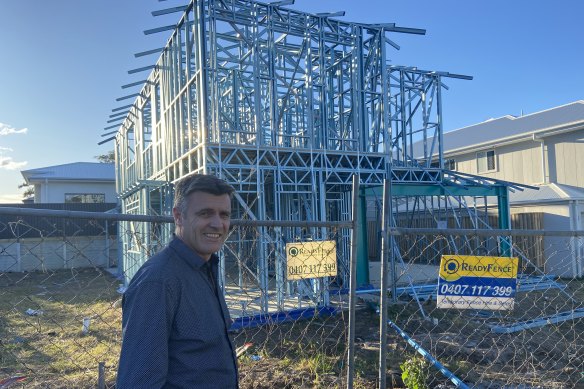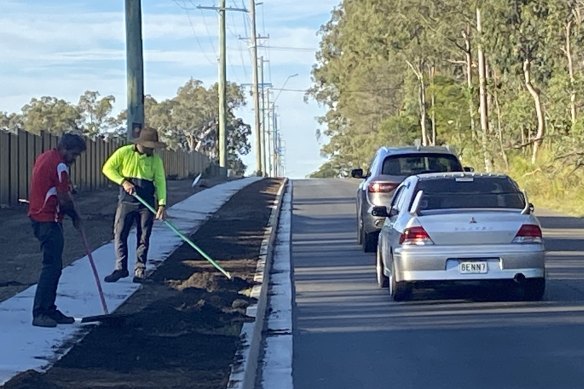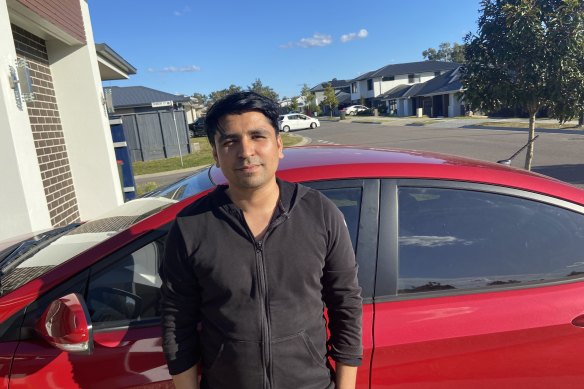This was published 2 years ago
Boom, but not bus: The transport issues facing Brisbane’s fast-growing multicultural fringe
By Tony Moore and Sean Parnell

Matt Ashton, 39, from Wales, moved to Pallara to build a new home. He loves the location, but says bus travel is “painful”, forcing him to drive.Credit: Tony Moore
In Pallara – Brisbane’s fastest-growing suburb – you can see the tall city towers of the Brisbane CBD 25 kilometres to the north from the top of Maldon Street.
And if you look in the opposite direction you can see over Forest Lake Boulevard, then over the Logan Motorway into Logan City, another of the high-growth hotspots in south-east Queensland.
The 2021 census data confirms Pallara, south of Inala and Doolandella and nestling on Logan at the end of the four-lane suburban highway that is Blunder Road, is one of Brisbane’s boom suburbs.
Pallara had Brisbane’s fastest growth rate (16 per cent) in 2020-21 and as the census data is slowly interrogated, local families have told how they came to be there.
While Queensland’s population has grown faster than any other state or territory, Pallara’s growth has jumped ahead full throttle at 18.9 per cent since 2011.

Turrisi Properties agent Andrew Sudholz says his company alone has sold 500 lots in the past 18 months.Credit: Tony Moore
Its residents tell of the strengths and weakness that growth exposes.
Turrisi Properties real estate agent Andrew Sudholz said his development company had sold almost 500 lots in the past 18 months, mostly to young professionals, from “lots of different nationalities”.
Two new residential estate developments have opened at Pallara on land that was previously small-acreage farms.
“Logan Motorway and Johnson Road is the boundary between Brisbane City Council and Logan City Council. If people are wanting to be within the 20-kilometre ring – and be within the Brisbane City Council area – you can’t go any further.”
Pallara: differences between the 2011 and 2021 census
In the 2011 census:
- There were 615 people living in 203 dwellings in Pallara, fairly evenly spread across age groups.
- Average number of people per dwelling was three, which was lower than the state average.
- 40.6% had both parents born overseas.
- 35.5% had two motor vehicles - lower than statewide average of 37.2% - but 36% had three or more vehicles, compared to the 17.3% statewide average.
In the 2021 census:
- There were 3857 people living in 1212 dwellings in Pallara, most in their 20s and 30s.
- Average number of people per dwelling was 3.7, which was higher than the state average of 3.2.
- 75.5% had both parents born overseas, with India the most common.
- 53.5% had two motor vehicles - higher than statewide average of 37.5% - and 17.8% had three vehicles.
He said Pallara’s land development took off “about three or four years ago” when council put in a new sewer main.
“And I would say around 80 per cent of the homes are owner occupied.”
IT specialist Matt Ashton, 39, came from Wales in 2011, settled in nearby Oxley and then shifted to Pallara two years ago.
“It was the closest place to where we were living, and it was the last Brisbane City Council land before you go into Logan,” Ashton says.
He acknowledges it has worked financially. After paying $650,000 for his land and house, it was recently revalued by the bank at $820,000.

Ritchie Road at Pallara. The pattern continues. Small farms and scrubland on Brisbane’s outskirts are being cleared to cope with population growth.Credit: Tony Moore
One of the downsides is public transport is not keeping pace with the rapid population growth.
“It is pretty poor. You need to go into Richlands station and then jump on a train. I’ve tried the Inala station as well, but it is a little bit too far a drive to make it convenient,” he says.
“There are no buses around here. You have to go down to Heathwood [next suburb]. The bus there will take you down through Forest Lake, but the transport is painful.”
He says the south side does not receive the benefits of the new rail or bus infrastructure, which is CBD-focused.
“It is unfortunate. It is a bit poor having to rely on driving into the CBD because that is not feasible in terms of parking or petrol.”
A few doors down on Maldon Street, Saad Silat and his wife, Huma, both 31, rely on their car.

Saad and Huma Zafar Silat love living at multicultural Pallara, but say poor bus transport forces them to drive everywhere.Credit: Tony Moore
Public transport is such a problem it forces Huma to drive.
“I used to take the bus, but now I just drive to work,” she says.
“The bus was just a long walk from our house.”
The couple first moved from Pakistan to Adelaide before shifting to Brisbane.
“We chose this suburb because we wanted to buy a house. We moved from New Farm – where we were renting – to Pallara three years and three months ago.”
Saad is an accountant, while Huma is a teacher. Their son was born in Pallara. There is a school and a preschool. They both have bachelor’s degrees, while Saad has a master’s degree in accountancy.
“When we were wanting to buy a house we were told that this was going to be one of the fastest-growing suburbs and it was likely to increase in value.”
They laughingly compare population growth in Australia with Pakistan’s capital of Karachi, which had 16.7 million.
“When we moved in it was pretty empty, but within a year, it was too many houses and too many people,” she jokes.
They both enjoy living at Pallara, which they describe as “very multicultural”.
“The majority of people are from everywhere, so it is good,” Huma says.
“And they all live happily. They are all pretty friendly, which is nice. I think no other country is like that.”
Vikas Kumar, 30, came to Pallara from northern India to live with his sister Suman and brother-in-law in 2019. He recently finished his master’s degree in accounting in Australia and works as an Uber driver.

Vikas Kumar came from India to Pallara two years ago and notices how clean Australia is compared with India.Credit: Tony Moore
“I am now looking for some managerial-type positions in small- to medium-sized businesses,” he says.
“I feel the quality of education in Australia is better than India.
“My friend travelled Australia in 2008. There has been a long tradition of Indians travelling to Australia.”
New Zealand-born Sharin Kahn works in a finance department and came to Brisbane six years ago from Auckland to search for land. They found a site at Pallara three years ago.
“It was within our budget and we liked it.
“We came here for the weather because New Zealand is so cold.
“I would say it is very multiracial, and it is a nice place. I have been to Sydney and Melbourne, so I know that this is a nice place.”